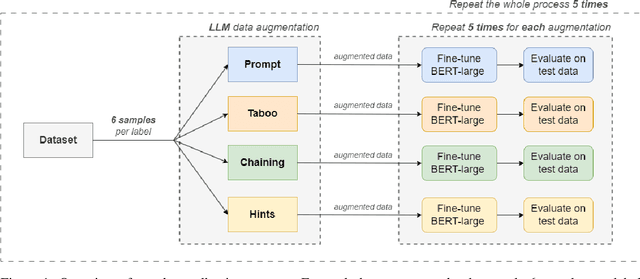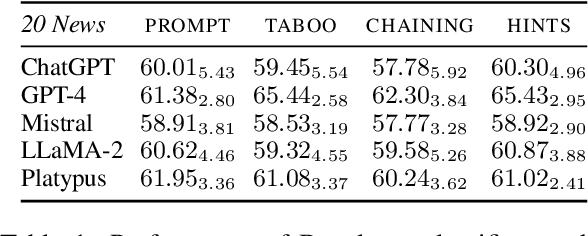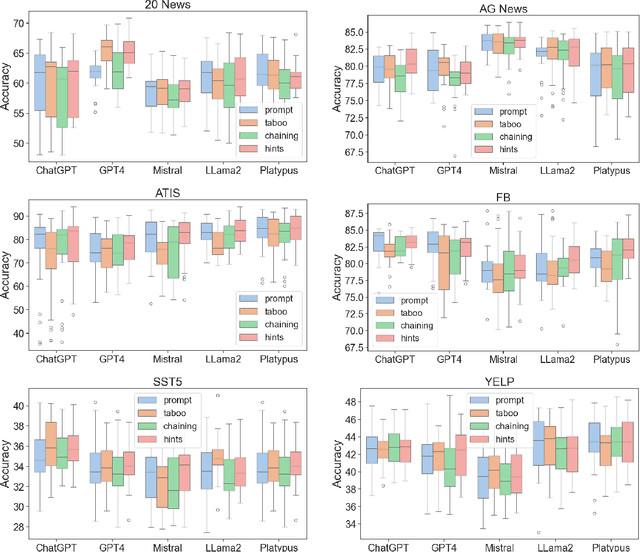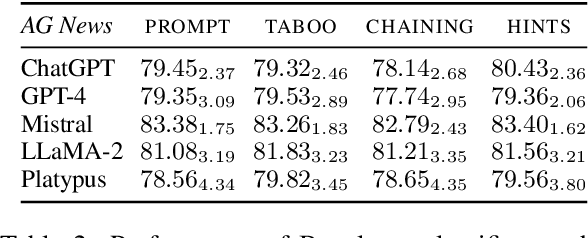Jan Cegin
A Rigorous Evaluation of LLM Data Generation Strategies for Low-Resource Languages
Jun 13, 2025Abstract:Large Language Models (LLMs) are increasingly used to generate synthetic textual data for training smaller specialized models. However, a comparison of various generation strategies for low-resource language settings is lacking. While various prompting strategies have been proposed, such as demonstrations, label-based summaries, and self-revision, their comparative effectiveness remains unclear, especially for low-resource languages. In this paper, we systematically evaluate the performance of these generation strategies and their combinations across 11 typologically diverse languages, including several extremely low-resource ones. Using three NLP tasks and four open-source LLMs, we assess downstream model performance on generated versus gold-standard data. Our results show that strategic combinations of generation methods, particularly target-language demonstrations with LLM-based revisions, yield strong performance, narrowing the gap with real data to as little as 5% in some settings. We also find that smart prompting techniques can reduce the advantage of larger LLMs, highlighting efficient generation strategies for synthetic data generation in low-resource scenarios with smaller models.
Use Random Selection for Now: Investigation of Few-Shot Selection Strategies in LLM-based Text Augmentation for Classification
Oct 14, 2024



Abstract:The generative large language models (LLMs) are increasingly used for data augmentation tasks, where text samples are paraphrased (or generated anew) and then used for classifier fine-tuning. Existing works on augmentation leverage the few-shot scenarios, where samples are given to LLMs as part of prompts, leading to better augmentations. Yet, the samples are mostly selected randomly and a comprehensive overview of the effects of other (more ``informed'') sample selection strategies is lacking. In this work, we compare sample selection strategies existing in few-shot learning literature and investigate their effects in LLM-based textual augmentation. We evaluate this on in-distribution and out-of-distribution classifier performance. Results indicate, that while some ``informed'' selection strategies increase the performance of models, especially for out-of-distribution data, it happens only seldom and with marginal performance increases. Unless further advances are made, a default of random sample selection remains a good option for augmentation practitioners.
LLMs vs Established Text Augmentation Techniques for Classification: When do the Benefits Outweight the Costs?
Aug 29, 2024Abstract:The generative large language models (LLMs) are increasingly being used for data augmentation tasks, where text samples are LLM-paraphrased and then used for classifier fine-tuning. However, a research that would confirm a clear cost-benefit advantage of LLMs over more established augmentation methods is largely missing. To study if (and when) is the LLM-based augmentation advantageous, we compared the effects of recent LLM augmentation methods with established ones on 6 datasets, 3 classifiers and 2 fine-tuning methods. We also varied the number of seeds and collected samples to better explore the downstream model accuracy space. Finally, we performed a cost-benefit analysis and show that LLM-based methods are worthy of deployment only when very small number of seeds is used. Moreover, in many cases, established methods lead to similar or better model accuracies.
Fighting Randomness with Randomness: Mitigating Optimisation Instability of Fine-Tuning using Delayed Ensemble and Noisy Interpolation
Jun 18, 2024Abstract:While fine-tuning of pre-trained language models generally helps to overcome the lack of labelled training samples, it also displays model performance instability. This instability mainly originates from randomness in initialisation or data shuffling. To address this, researchers either modify the training process or augment the available samples, which typically results in increased computational costs. We propose a new mitigation strategy, called Delayed Ensemble with Noisy Interpolation (DENI), that leverages the strengths of ensembling, noise regularisation and model interpolation, while retaining computational efficiency. We compare DENI with 9 representative mitigation strategies across 3 models, 4 tuning strategies and 7 text classification datasets. We show that: 1) DENI outperforms the best performing mitigation strategy (Ensemble), while using only a fraction of its cost; 2) the mitigation strategies are beneficial for parameter-efficient fine-tuning (PEFT) methods, outperforming full fine-tuning in specific cases; and 3) combining DENI with data augmentation often leads to even more effective instability mitigation.
Effects of diversity incentives on sample diversity and downstream model performance in LLM-based text augmentation
Jan 12, 2024



Abstract:The latest generative large language models (LLMs) have found their application in data augmentation tasks, where small numbers of text samples are LLM-paraphrased and then used to fine-tune the model. However, more research is needed to assess how different prompts, seed data selection strategies, filtering methods, or model settings affect the quality of paraphrased data (and downstream models). In this study, we investigate three text diversity incentive methods well established in crowdsourcing: taboo words, hints by previous outlier solutions, and chaining on previous outlier solutions. Using these incentive methods as part of instructions to LLMs augmenting text datasets, we measure their effects on generated texts' lexical diversity and downstream model performance. We compare the effects over 5 different LLMs and 6 datasets. We show that diversity is most increased by taboo words, while downstream model performance is highest when previously created paraphrases are used as hints.
ChatGPT to Replace Crowdsourcing of Paraphrases for Intent Classification: Higher Diversity and Comparable Model Robustness
May 22, 2023



Abstract:The emergence of generative large language models (LLMs) raises the question: what will be its impact on crowdsourcing. Traditionally, crowdsourcing has been used for acquiring solutions to a wide variety of human-intelligence tasks, including ones involving text generation, manipulation or evaluation. For some of these tasks, models like ChatGPT can potentially substitute human workers. In this study, we investigate, whether this is the case for the task of paraphrase generation for intent classification. We quasi-replicated the data collection methodology of an existing crowdsourcing study (similar scale, prompts and seed data) using ChatGPT. We show that ChatGPT-created paraphrases are more diverse and lead to more robust models.
 Add to Chrome
Add to Chrome Add to Firefox
Add to Firefox Add to Edge
Add to Edge